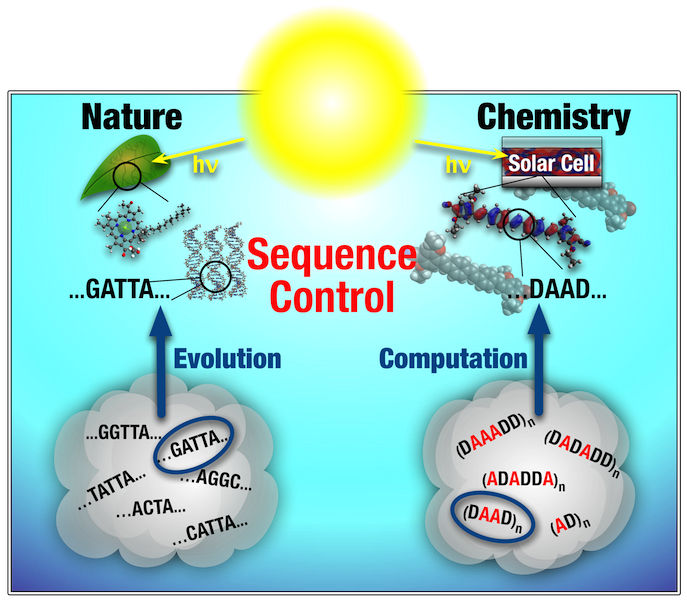Sequence Matters: Modulating Electronic and Optical Properties of Conjugated Oligomers via Tailored Sequence
Benjamin N. Norris, Shaopeng Zhang, Casey M. Campbell, Jeffrey T. Auletta, Percy Calvo-Marzal, Geoffrey R. Hutchison, Tara Y. Meyer. “Sequence Matters: Modulating Electronic and Optical Properties of Conjugated Oligomers via Tailored Sequence” Macromolecules 2013 46(4) 1384–1392. Online. The supplemental info is available here: Norris SI.
 Although sequence must necessarily affect the photophysical properties of oligomers and copolymers prepared from donor and acceptor monomers, little is known about this effect, as nearly all the donor/acceptor materials have an alternating structure. A series of sequenced para-phenylene- vinylene (PV) oligomers was synthesized and investigated both experimentally and computationally. Using Horner-Wadsworth-Emmons (HWE) chemistry, a series of dimers, trimers, tetramers, pentamers, and hexamers were prepared from two building block monomers, a relatively electron-poor unsubstituted p-phenylene-vinylene (A) and an electron-rich dialkoxy-substituted p-phenylene-vinylene (B). UV-Vis absorption/emission spectra and cyclic voltammetry demonstrated that the optoelectronic properties of these oligomers depended significantly on sequence. Calculations predicting the HOMO-LUMO gap of the sequenced oligomers correlated well with the experimental properties for the 2- to 4-mers, and the consensus model developed was used to design hexameric sequences with targeted characteristics. Despite the weak acceptor qualities of the “A” monomer employed in the study, HOMO-LUMO gap differences of ~0.25 eV were found for isomeric, sequenced oligomers. In no case did the alternating structure give the largest or smallest gap. The use of sequence as a strategy represents a new dimension in tailoring properties of π-conjugated polymers.
Although sequence must necessarily affect the photophysical properties of oligomers and copolymers prepared from donor and acceptor monomers, little is known about this effect, as nearly all the donor/acceptor materials have an alternating structure. A series of sequenced para-phenylene- vinylene (PV) oligomers was synthesized and investigated both experimentally and computationally. Using Horner-Wadsworth-Emmons (HWE) chemistry, a series of dimers, trimers, tetramers, pentamers, and hexamers were prepared from two building block monomers, a relatively electron-poor unsubstituted p-phenylene-vinylene (A) and an electron-rich dialkoxy-substituted p-phenylene-vinylene (B). UV-Vis absorption/emission spectra and cyclic voltammetry demonstrated that the optoelectronic properties of these oligomers depended significantly on sequence. Calculations predicting the HOMO-LUMO gap of the sequenced oligomers correlated well with the experimental properties for the 2- to 4-mers, and the consensus model developed was used to design hexameric sequences with targeted characteristics. Despite the weak acceptor qualities of the “A” monomer employed in the study, HOMO-LUMO gap differences of ~0.25 eV were found for isomeric, sequenced oligomers. In no case did the alternating structure give the largest or smallest gap. The use of sequence as a strategy represents a new dimension in tailoring properties of π-conjugated polymers.